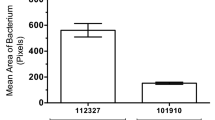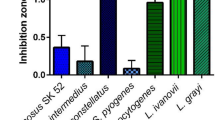Abstract
THE virulence of organisms can be enhanced by a variety of substances, mainly of carbohydrate nature (see review by Olitzki1). Current interest centres on mucin, which was found by Smith and his co-workers2–4 to owe its activity to the synergic action of three factors—viscosity, a particulate residue and a heparin. The present communication shows that bacteriological peptone and some of its hydrolysis products also have considerable virulence-enhancing activity.
This is a preview of subscription content, access via your institution
Access options
Subscribe to this journal
Receive 51 print issues and online access
$199.00 per year
only $3.90 per issue
Buy this article
- Purchase on Springer Link
- Instant access to full article PDF
Prices may be subject to local taxes which are calculated during checkout
Similar content being viewed by others
References
Olitzki, L., Bact. Rev., 12, 149 (1948).
Smith, H., Harris-Smith, P. W., and Stanley, J. L., Biochem. J., 50, 211 (1951).
Smith, H., Gallop, R. C., and Stanley, J. L., Biochem. J., 52, 15 (1952).
Smith, H., Gallop, R. C., Harris-Smith, P. W., and Stanley, J. L., Biochem. J., 52, 23 (1952).
Miles, A. A., and Misra, S. S., J. Hyg. (Camb.), 38, 732 (1938).
Author information
Authors and Affiliations
Rights and permissions
About this article
Cite this article
CAMERON, J. Enhancement of Mouse-virulence of Group A Streptococci. Nature 180, 1136–1137 (1957). https://doi.org/10.1038/1801136b0
Issue Date:
DOI: https://doi.org/10.1038/1801136b0
This article is cited by
Comments
By submitting a comment you agree to abide by our Terms and Community Guidelines. If you find something abusive or that does not comply with our terms or guidelines please flag it as inappropriate.



